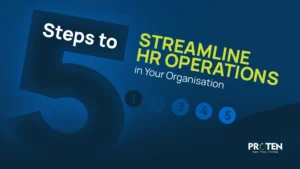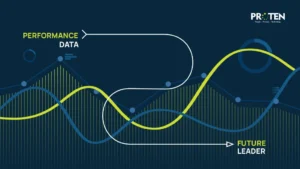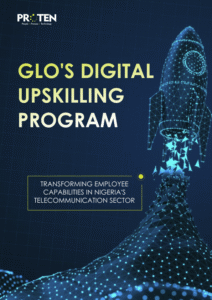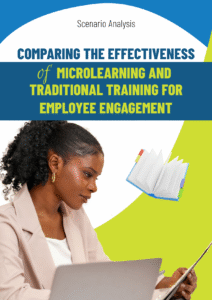Meet Fred, a seasoned cybersecurity engineer with a reputation as a digital fortress architect. Earlier this week, Fred was presented with a tantalizing opportunity. A prominent bank, renowned for its financial prowess but struggling to fortify its digital defenses, is seeking his expertise. On the surface, it seems like a perfect match – a high-profile position at an institution with a global footprint. However, Fred notices five concerning loopholes in the bank’s recruitment process that makes him think twice.
The landscape of talent acquisition has undergone a dramatic shift, particularly since 2020, because of COVID-19. The pandemic accelerated trends like remote work, flexible schedules, and a heightened emphasis on work-life balance. Because of this, employee turnover rates have swiftly been on the rise, with a rate of 47% as of 2023. Consequently, the bar for what constitutes an attractive employer value proposition (EVP) has been raised significantly. While many businesses have adapted to these changes, a considerable number still lag behind, presenting a stark challenge in attracting top talent like Fred.
Would you like to know more about what Fred discovered? We’re going to be taking a look at each of them and breaking them down. And at the end, we’ll let you know what you can do to redeem yourself if you notice these same loopholes in your company.
Why You Need To Define Your EVP.
But before we dive into what our cybersecurity engineer discovered, let’s talk about why you need to define your EVP. You’ve heard that word before, and in case you haven’t, it’s the abbreviation for your Employer Value Proposition.
Your EVP is more than a mere list of benefits; it’s your company’s soul, encapsulated in a compelling narrative that resonates with potential employees. It’s the promise of what someone can expect while working with you, beyond the monetary compensation. And a well-defined EVP differentiates a company from its competitors, attracting and retaining top talent.
So you could say, that your EVP is like your Resume, just for employers, like you.
When you fail to articulate a clear EVP, it’s like building a house without a blueprint. There’s no guiding principle to unify recruitment efforts, employee engagement strategies, or company culture. Without a strong EVP, you risk becoming a faceless entity in the minds of potential employees, overlooked in favor of your competitors who offer similar perks. A defined EVP is the compass that directs your company toward its ideal workforce. It serves as a filter for recruitment, ensuring that new hires align with your values and goals. Moreover, it builds a sense of belonging and purpose among employees, enhancing job satisfaction and reducing turnover. In essence, a strong EVP is the foundation upon which your company is built. It’s the magnetic force that attracts top talent, nurtures employee loyalty, and ultimately drives business success.
Now that we’ve cleared this, we can cover the five things Fred noticed in the bank’s recruitment process that made him change his mind.
Reason 1: The Company Didn’t Provide Enough Information About The Job.
As Fred looked deeper into the job description. a sense of frustration began to creep in. The job posting was a generic outline, lacking specific challenges and responsibilities that would truly define the role. It was as if the company was casting a wide net, hoping to catch any fish that swam by. This lack of clarity was a red flag for Fred, as it suggested a potential mismatch between his skills and the actual demands of the position.
A well-crafted job description is more than just a list of requirements. It’s a powerful tool for attracting qualified candidates and setting expectations. Failing to invest time and effort into creating informative and engaging job descriptions, increases your risk of losing top talent to competitors who are more transparent about the role. Take a poorly crafted job description like a blurry photograph – you know it’s a photograph alright, but you can’t really see what the photograph is of. And how many people do you think would wait and try to figure the photo out? If your potential candidates can’t clearly envision their day-to-day responsibilities, they’re less likely to apply, or worse, accept a job that doesn’t align with their expectations.
This will lead to higher turnover rates and increased recruitment costs.
Furthermore, vague job descriptions can deter top talent. Professionals with in-demand skills are often shoved with job offers. They expect clarity and specificity in job postings. A poorly written job description signals a lack of organization and attention to detail, which can negatively impact your employer brand. To compound the issue, inadequate job descriptions can hinder the screening process. Without clear qualifications and responsibilities outlined, you may struggle to identify suitable candidates, wasting time and resources.
In Fred’s case, the generic job description suggested a company that wasn’t serious about finding the right fit. It implied a lack of understanding of the role’s critical nature, which is particularly concerning in a field as specialized as cybersecurity.
Reason 2: The Company’s Hiring Process Was Not Organized.
Fred’s journey through the recruitment process felt more like navigating a labyrinth than a straightforward path. There were too many steps and redundant information requests. It was as if the company hadn’t streamlined its hiring process, leading to a frustrating experience for candidates. A chaotic recruitment process reflects poorly on your company’s overall efficiency and organizational health. Top talents value their time and expect a smooth, professional experience. When candidates encounter obstacles and delays, it creates a negative impression of your company’s culture.
Moreover, a disorganized hiring process can lead to missed opportunities. Talented candidates are often considering multiple offers. If you can’t move swiftly through the recruitment stages, you might lose them to competitors. A disorganized hiring process doesn’t just frustrate candidates; it also impacts the bottom line. When you waste time and resources on inefficient recruitment practices, it translates to higher costs per hire. This is especially true when top talents become impatient and withdraw their application due to a prolonged and chaotic process. Additionally, a disorganized hiring process can damage your employer brand. Negative candidate experiences spread quickly through social media and online review platforms. This can deter potential applicants from considering your company, leading to a smaller talent pool.
Furthermore, a chaotic recruitment process can impact employee morale. When hiring managers are overwhelmed and stressed due to inefficient systems, it can create a negative work environment. This, in turn, can lead to increased turnover and decreased productivity.
In Fred’s case, the bulky application process reinforced his perception of the bank as an organization that lacked efficiency and a candidate-centric approach. It made him question whether he would face similar challenges once employed, which ultimately influenced his decision to withdraw his application.
Reason 3: The Salary Wasn’t Worth It.
Fred’s already diminished morale waned even further as he looked through the compensation package. The offered salary, while competitive on paper, fell short of industry standards for a role of his caliber. It was evident that the company had not conducted thorough salary benchmarking, a critical step in attracting top talent.
A competitive salary is often the first criterion candidates consider when evaluating a job offer. In today’s tight labor market, underpaying skilled professionals is a recipe for disaster. It not only discourages top candidates from applying but also leads to higher turnover rates as employees seek better compensation elsewhere. Furthermore, a low salary offer can damage your EVP. Word of mouth travels fast, and news of a company’s stinginess with compensation can spread quickly. This can deter potential candidates from considering your company, even if other aspects of the job are appealing.
Salary benchmarking is the cornerstone of competitive compensation. It involves systematically gathering data on salary ranges for specific job roles within a particular industry and geographic location. Failing to conduct thorough salary benchmarking puts you at risk of offering salaries that are either too low, leading to high turnover and making recruitment even harder for you, or too high, impacting profitability.
In Fred’s case, the salary offer was a clear indication that the company undervalued his expertise. It reinforced his decision to withdraw his application, as he was confident in his ability to secure a more competitive compensation package elsewhere.
Reason 4: The Company Did Not Provide Flexible Work Options.
Fred, being a cybersecurity expert, is a digital nomad. So it’s no surprise that he was taken aback by the bank’s rigid work-from-home policy. In an era where remote work has become the norm for many industries, the bank’s insistence on traditional office hours was a stark contrast to the flexibility offered by other employers.
The ability to offer flexible work arrangements has become a critical factor in attracting and retaining top talent. Employees value the autonomy to balance their personal and professional lives. Failing to adapt to this trend puts you at risk of losing out to competitors who offer more modern and accommodating work policies. Furthermore, a lack of flexibility can limit a company’s talent pool. By restricting employment to individuals who can physically commute to an office, you’re excluding a significant portion of your potential workforce, including highly skilled professionals who may prefer remote or hybrid work arrangements.
Flexible work arrangements offer a myriad of advantages for both you and your employees. Beyond work-life balance, they boost employee morale, productivity, and job satisfaction. You benefit from reduced overhead costs, access to a wider talent pool, and increased employee retention. Moreover, flexible work arrangements foster a culture of trust and autonomy, empowering your employees to take ownership of their work and achieve optimal results.
In Fred’s case, the bank’s rigid work policy was a deal-breaker. It signaled a company that was resistant to change and unwilling to accommodate the needs of its employees.
Reason 5: Fred Heard Their “Gist”
He had heard the rumors before but decided to ignore them. But after noticing the other problems, he decided to reconsider them. He had heard whispers about the bank’s internal culture. Tales of office politics, infighting, and a lack of transparency painted a picture of a toxic work environment. This reputation for being a “drama-filled” workplace was a significant deterrent.
Top talent seeks companies with positive work cultures. A strong emphasis on teamwork, collaboration, and employee well-being is essential for attracting and retaining top performers. When your company is known for its internal strife, it becomes a less attractive option for professionals seeking a fulfilling and rewarding career. Moreover, a toxic work environment can lead to high turnover rates, impacting productivity, morale, and overall company performance. It creates a vicious cycle where talented employees are reluctant to join, and existing employees are eager to leave.
And no, playing the power move and getting people arrested for spreading the word won’t help the situation. As a matter of fact, you will only prove them right, and make things worse for you.
A toxic work culture is a significant driver of employee turnover. When your employees are subjected to constant negativity, lack of support, or unfair treatment, they are more likely to seek employment elsewhere. This not only impacts your company’s bottom line through increased recruitment and training costs but also damages its reputation, making it difficult to attract top talent.
In Fred’s case, the negative reputation of the bank’s culture was the final nail in the coffin. He realized that even if the company offered the perfect job description, salary, and work-life balance (which it didn’t even), the overall work environment would likely be detrimental to his well-being and career growth.
So, What Can The Bank Do To Redeem Its EVP?
Fred finally withdrew their offer, to the devastation of the global bank. And he wasn’t the only applicant who did. A lot of others had reasons to drop the company and focus on other competitors. This is not the first time the bank has experienced such. And they’re not the first company experiencing such either. If your company is just like this bank, the solution is not to fire your recruitment personnel or to push your job offer more on social media. Because nothing will change.
Except you do. And by you, we mean your Job description, hiring process, and EVP.
Crafting compelling job descriptions is the first step to attracting top talent. A well-written job description should clearly outline the role, responsibilities, and qualifications while also giving potential candidates a glimpse into the company culture. It’s essential to move beyond generic job descriptions and create content that resonates with the target audience. And don’t forget to conduct proper salary benchmarking to ensure that the salary is worth the job description.
In addition to this, a streamlined hiring process is crucial for attracting top talent. Candidates expect a smooth and efficient application experience. To achieve this, you should eliminate redundant steps, reduce application time, and provide regular communication updates. Implementing applicant tracking systems (ATS) can help automate and organize the hiring process. Additionally, leveraging technology to conduct initial screening, such as video interviews or online assessments, can save time and resources.
Furthermore, your recrafting your employer branding is important if you want to attract top talent. It involves shaping your perception as an employer of choice. To build a strong employer brand, you should focus on their company culture, values, and employee experience. Effective communication channels, such as social media and employee advocacy programs, can help spread positive messages about your company. Additionally, highlighting employee success stories and showcasing company initiatives can enhance Your EVP.
By following these steps dedicatedly, you can be sure to build a strong reputation as a McGuffin of employers.
In Conclusion…
Talent acquisition has evolved into a complex challenge for businesses across industries. The days of relying on traditional recruitment methods are long gone. To thrive in today’s competitive landscape, organizations must prioritize a strategic approach to talent acquisition. By defining a clear employer value proposition, optimizing the hiring process, and cultivating a strong employer brand, you can attract and retain top talent. Investing in these areas is not merely an expense but a strategic investment in the future success of the organization.
Remember, talent is the lifeblood of any business. By addressing the challenges earlier and implementing effective solutions, you can position themselves as an employer everyone wants to work for, and build high-performing teams capable of driving growth and innovation.
If you’re struggling to find the right talent for your organization, consider partnering with us. With over a decade in the industry, we’ve have honed our skills in identifying top talent and matching them with the perfect roles. Our seamless recruitment process, leveraging the latest strategies and technologies, ensures that your hiring needs are met efficiently and effectively. Reach out to us today and let’s discuss how we can help you craft a solid job description and build a world-class team.










